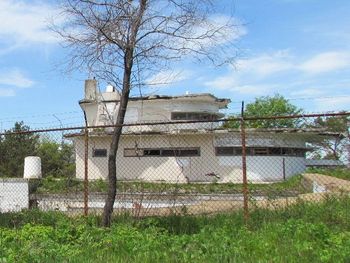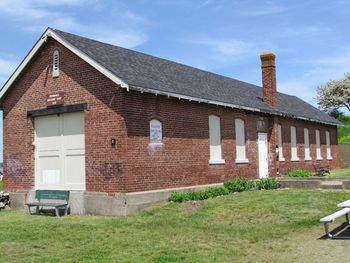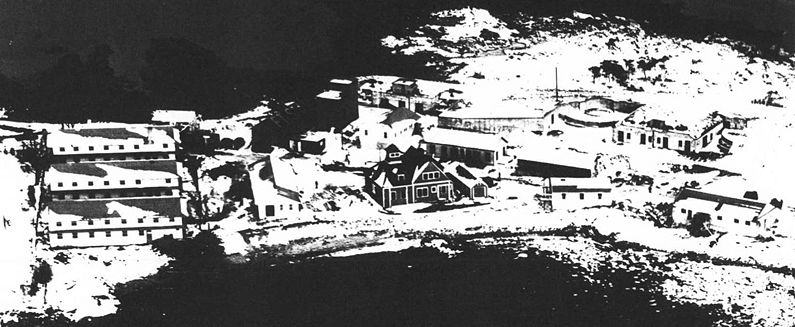Fort Stark
| More information at Warlike, Wikipedia
Fort Stark (1873-1948) - An Endicott Period Coastal Fort first established in 1873 on the site of previous fortifications. Located on Jerry's Point, New Castle Island, Rockingham County, New Hampshire. Named Fort Stark in G.O. 43, 4 Apr 1900, after Brigadier General John Stark, who in command of the New Hampshire forces at the Battle of Bennington, 16 Aug 1777, achieved a brilliant victory, for which he was awarded the thanks of Congress and a commission as a brigadier general in the Continental Army, in which position he served with unusual distinction until the close of the Revolutionary War. Post turned over to the U.S. Navy in 1948.
Endicott Period (1890-1910)Part of the Harbor Defense of Portsmouth, New Hampshire. The land for this small 10-acre post was acquired on 14 March 1873 from a John A. Lambert. Previous batteries had been located on this land prior to and during the Revolutionary War. Endicott Period construction began in 1898 with a temporary battery of two modified 8" Rodman guns. Construction began in 1901 on the four permanent Endicott Period batteries and they were all completed and turned over to the artillery in December 1904 and April 1905. In G.O. 13, 2 Feb 1905, Fort Stark was announced as having been turned over to the Artillery and become a sub-post of Fort Constitution (2), New Hampshire. Following this announcement the post is shown as garrisoned by detachment or in caretaker status. Permanent barracks were not built on the post and only three permanent buildings existed. One of the permanent buildings was a former life-saving station and it served as NCO quarters for the ordnance sergeant caretaker and sometimes as a makeshift barracks. The only other habitable permanent building was an ordnance repair shop built in 1910.
A mining casemate and M' station were accepted for service on 27 Sep 1907.
World War I (1917-1918)The guns 6" of Battery Kirk were ordered dismounted for use abroad on 24 Aug 1917 and they were transferred to Watervliet on 28 Sep 1917. Both guns made it to France in 1918 and they were returned to the United States in 1919 but not to Fort Stark. Battery Kirk was not rearmed. During World War I several temporary buildings including two barracks buildings were squeezed onto the small reservation allowing a more permanent garrison during the war. These temporary buildings can still be seen on the 1921 plan.

World War II (1941-1945)At the beginning of World War II three of the original Endicott Period batteries were still active but by the end of the war only Battery Lytle was still active. Battery Hunter (2) was ordered salvaged in January 1945 and Battery Hays had been deactivated in 1942.  In 1941 temporary barracks and other facilities were built as a part of the peacetime buildup in anticipation of a coming war. Three temporary enlisted barracks, a six-man BOQ and a mess hall were built along the northern edge of the reservation. Additional temporary support structures brought the total number of buildings on the post to 12. Post capacity rose to 6 officers and 189 enlisted troops. In 1943-44 a combined Harbor Entrance Control Post (HECP) and Harbor Defense Command Post (HDCP) was built into the magazine structure of the deactivated Battery Kirk. This facility included a new three-floor concrete observation station built on top of the magazine structure with an SCR-682 RADAR set on top of that. The observation station structure was disguised as a modernistic building with camouflaged paint. This facility was accepted for service on 10 Jan 1944 at a cost of $ 93,398.77.
Cold War (1947-1991)The U.S. Navy took over Fort Stark in 1948 and used it primarily for reserve training. The property was deeded to the State of New Hampshire in 1983. The State established Fort Stark State Historic Site. Current StatusPart of Fort Stark State Historic Site, Jerry's Point, New Castle Island, Rockingham County, New Hampshire.
See Also:
Sources:
Links:
Visited: 7 Jun 2012 | |||||||||||||||||||||||||||||||||||||||||||||||||||||||


